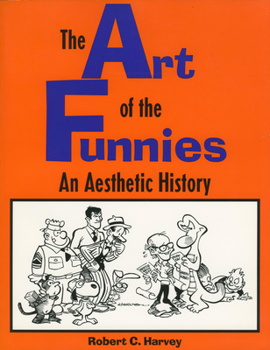The Art of the Funnies: An Aesthetic History
(Part of the Studies in Popular Culture Series Series)
Select Format
Select Condition 
Book Overview
The comic strip was created by rival newspapers of the Hearst and the Pulitzer organizations as a device for increasing circulation. In the United States it quickly became an institution that soon... This description may be from another edition of this product.
Format:Paperback
Language:English
ISBN:0878056742
ISBN13:9780878056743
Release Date:July 1994
Publisher:University Press of Mississippi
Length:298 Pages
Weight:1.70 lbs.
Dimensions:0.7" x 8.6" x 11.0"
Customer Reviews
2 ratings
A good book
Published by Thriftbooks.com User , 17 years ago
In his seminal 1979 essay "The Aesthetics of the Comic Strips" ( in the Journal of Popular Culture) Robert Harvey argued that serious critical discussion of comics required an articulated theory of comic aesthetics. This volume, which opens with a reworked version of that essay, offers a history of comic strip art that flows from Harvey's two main premises: 1. Comics are unique in the way they "weave word and picture together to achieve narrative purpose" (p. 9). 2. The criteria for evaluating comic strips can be found in the history of the form because artists gave different ingredients of the form their finest expression in the "great" strips (pp. 11-12). Although The Art of the Funnies covers many of the same artists as Richard Marschall's America's Great Comic-Strip Artists (Abbeville Press)- the usual suspects McCay, Herriman, Segar, Raymond, Caniff, and the rest - Harvey explains why and how individual strips were great. For instance, Milton Caniff's Terry and the Pirates stands out as much for Caniff's witty counterpoising of images and text as it does for his use of chiaroscuro techniques. One of the strengths of Harvey's account is that he draws his explanation out of the comic strips he reproduces in the volume rather than expecting his audience to acknowledge intrinsically that his favorite artists are great. Harvey's careful argumentation sets him apart from other comic strip commentators. Whereas other writers seem to engage in conjecture and flights of fancy Harvey footnotes the sources for his opinions and explains his logic. I also find it refreshing to read a work on comics in which, as far as I can tell from my own research, every date is correct. Another of Harvey's accomplishments is to extend the social context in which comics developed beyond the usual accounts about the growth of newspaper chains and features syndicates. He cites the importance of copyright laws and the maturation of consumerism in the 1920s as crucial factors that shaped comic strips. Harvey's attention to these sorts of details make his book a convincing read. The aesthetic sensibilities Harvey brings to his readings of comic strips made me wish he had tackled the issue of caricature and racial stereotypes in comic art. He briefly touches on this subject when discussing Mort Walker's introduction of a black character to Beetle Bailey, but a fuller examination seems in order. Martin Barker, in his Comics: Ideology, Power, & The Critics (Manchester University Press), dismissed comic art stereotypes as a non issue in a field where all representation is caricature, but a fuller discussion of this issue seems warranted. To return to Caniff what can we make of the Chinese sidekick Connie's language and visual representation compared to the mysterious sexuality of the other major Chinese character, the Dragon Lady. Harvey's suggestion that the strip's reader wanted sexy oriental women, and by extension Yellow Kid like Chinese cooks, and that presenting t
Peddlers and Poets Abound
Published by Thriftbooks.com User , 24 years ago
Once again R.C. Harvey has laid bare the skeletal structure of what makes comics a truly great medium of personal expression and artistic accomplishment. His insightful and often poignant anecdotes help bring the casual comics reader to a level of deeper appreciation and reverence for what many people regard as "kids stuff". Most touching is his examination of George Herriman in Chapter 10. His ability so see beyond the surface "gags" and expose the boundless themes of love and pain truly make Herriman the metaphysical poet that Harvey titles him. Harvey's own observations are particualrly powerful and coalesque into not just an observation on the art of the funnies or the medium of comics in general, but serve as a reminder that all art is a personel expression and that these "comics" can be a bridge to a deeper understanding of human nature and American society.






